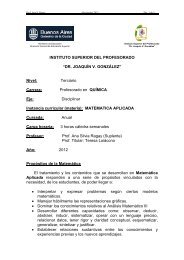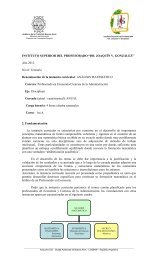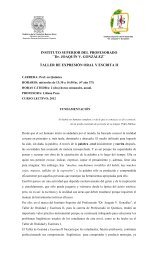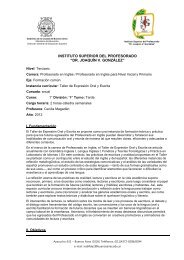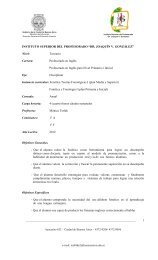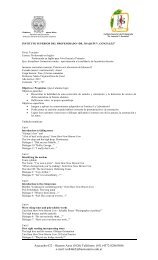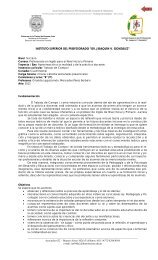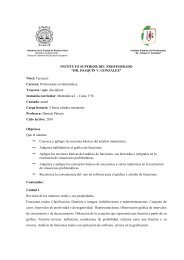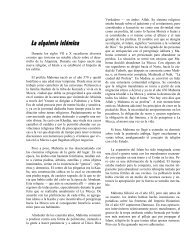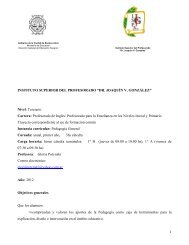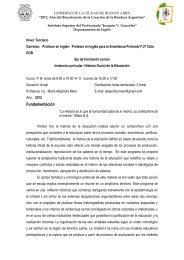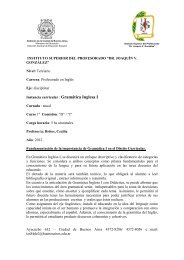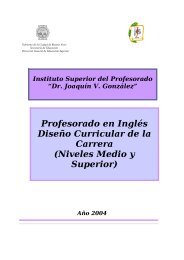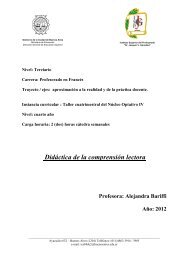Sesiones parale<strong>la</strong>s / Parall<strong>el</strong> sessionstiles (PIs), un tipo <strong>de</strong> institución cuyo objectivo era <strong>la</strong> inserción <strong>de</strong> chicos <strong>de</strong>3 a 14 años <strong>en</strong> <strong>la</strong> cultura brasileña. Hoy <strong>en</strong> día, <strong>el</strong> cuidado con los niños <strong>en</strong> <strong>la</strong>sinstituciones <strong>de</strong> educación infantil recibe más at<strong>en</strong>ción, porqué hay un reconocimi<strong>en</strong>tocada vez más gran<strong>de</strong> <strong>de</strong> que <strong>el</strong><strong>la</strong>s influy<strong>en</strong> <strong>de</strong> modo crítico <strong>en</strong> su<strong>de</strong>sarollo. Así, es importante que se conozca su <strong>historia</strong>, para compr<strong>en</strong><strong>de</strong>r mejorpor qué <strong>la</strong> Educación Infantil todavía recibe m<strong>en</strong>os inversión que <strong>la</strong>s otrasetapas <strong>de</strong> <strong>la</strong> <strong>en</strong>señanza. Nuestra investigación buscó conocer cómo esta <strong>historia</strong>tuvo inicio <strong>en</strong> <strong>la</strong> ciudad <strong>de</strong> Ribeirão Preto-SP. Para <strong>el</strong>lo, utilizamos <strong>la</strong> metodología<strong>de</strong> <strong>la</strong> <strong>historia</strong> <strong>oral</strong>, reconocida como <strong>historia</strong> viva <strong>de</strong>l tiempo pres<strong>en</strong>te.Fueron realizadas <strong>en</strong>trevistas, gravadas y transcritas integralm<strong>en</strong>te, con profesoresy empleados os jubi<strong>la</strong>dos o no <strong>de</strong> EMEIs antiguas <strong>de</strong> <strong>la</strong> ciudad.. La falta<strong>de</strong> at<strong>en</strong>ción con <strong>la</strong> preservación <strong>de</strong> docum<strong>en</strong>tos historicos es a<strong>la</strong>rm<strong>en</strong>te, yaque pue<strong>de</strong> perjudicar <strong>el</strong> trabajo <strong>de</strong> reconstrucción <strong>de</strong> nuestro pasado. En estecontexto, los resultados <strong>de</strong> nuestras <strong>en</strong>trevistas <strong>de</strong>stacan lo cuánto <strong>la</strong> <strong>historia</strong><strong>oral</strong> contribuye con <strong>el</strong> trabajo historiográfico, una vez que esta metodologíales da voz a personas que g<strong>en</strong>eralm<strong>en</strong>te son olvidadas <strong>en</strong> <strong>la</strong> construcción <strong>de</strong><strong>la</strong> “<strong>historia</strong> oficial”. <strong>Los</strong> re<strong>la</strong>tos <strong>de</strong> los participantes permitieron <strong>la</strong> e<strong>la</strong>boración<strong>de</strong> un retrato <strong>de</strong> <strong>la</strong> educación ofrecida <strong>en</strong> <strong>la</strong>s EMEIs (<strong>de</strong>s<strong>de</strong> cuando eran PIs) <strong>de</strong>Ribeirão Preto, como pres<strong>en</strong>tamos <strong>en</strong> este estudio.——————————————————————————————————————————————11 a 11.15 – Coffee Break——————————————————————————————————————————————11.15 a 13.15 horasC<strong>en</strong>tro Cultural G<strong>en</strong>eral San Martín——————————————————————————————————————————————Subtema / Subteme 2Teoría, método y <strong>en</strong>señanza <strong>de</strong> <strong>la</strong> <strong>historia</strong> <strong>oral</strong> /Theory, method and .the teaching and learning ofOral HistorySa<strong>la</strong> C - Mesa / Session 71Coordinan / Chair: Alicia Gartner y Dani<strong>el</strong> Plotinsky——————————————————————————————————————————————LE ROUX, Cheryl S.Confi<strong>de</strong>ntiality and anonymity in <strong>oral</strong> history research:the question of empowerm<strong>en</strong>t, autonomyand b<strong>en</strong>efic<strong>en</strong>ceOral history (OH) researchers are gui<strong>de</strong>d by specific co<strong>de</strong>s of ethics. A primaryfeature of these co<strong>de</strong>s is the issue of informed cons<strong>en</strong>t which <strong>en</strong>sures researchparticipants’ right to privacy, confi<strong>de</strong>ntiality and anonymity. In this article Iargue that the b<strong>la</strong>nket application of the principle of anonymity to all OH researchcould w<strong>el</strong>l be counterproductive to the purported aims of this type ofresearch. Four rationales for doing OH are discussed and each is positionedwithin the dominant philosophical framework that informs the purpose of theresearch and the way it is approached. Examples are extracted from the <strong>de</strong>scriptionsof these categories to exp<strong>la</strong>in where the principle of anonymity couldbe at variance with the research aims. It was found that wh<strong>en</strong> OH research setsout to contribute to historical un<strong>de</strong>rstanding and knowledge, validate participants’lives, contribute to <strong>de</strong>mocracy and facilitate socio-political transformation,<strong>en</strong>forcing anonymity has the pot<strong>en</strong>tial to <strong>de</strong>m<strong>oral</strong>ise or <strong>de</strong>nigrate theresearch participant and jeopardise credibility and researcher participation.I do not propose that anonymity be waived in all OH research, but rather thatresearchers question the ext<strong>en</strong>t to which the application of the principle restrictsthem from achieving their mandate of affording research participants’dignity, respect, autonomy and b<strong>en</strong>efic<strong>en</strong>ce.Investigadores <strong>de</strong> <strong>historia</strong> <strong>oral</strong> se guían por códigos éticos específicos. Una <strong>de</strong><strong>la</strong>s características primarias <strong>de</strong> estos códigos es <strong>la</strong> cuestión <strong>de</strong>l cons<strong>en</strong>timi<strong>en</strong>toinformado, <strong>el</strong> cual garantiza <strong>el</strong> <strong>de</strong>recho a <strong>la</strong> intimidad, a <strong>la</strong> confi<strong>de</strong>ncialidady al anonimato <strong>de</strong> los participantes <strong>de</strong> una investigación. En este artículosost<strong>en</strong>go que <strong>la</strong> aplicación g<strong>en</strong>eralizada <strong>de</strong>l principio <strong>de</strong> anonimato <strong>en</strong> todas<strong>la</strong>s investigaciones <strong>de</strong> <strong>historia</strong> <strong>oral</strong> podría ser contraproduc<strong>en</strong>te para los objetivospret<strong>en</strong>didos <strong>de</strong> este tipo <strong>de</strong> investigación. Se discut<strong>en</strong> cuatro categoríaslógicas para e<strong>la</strong>borar una <strong>historia</strong> <strong>oral</strong> y cada una <strong>de</strong> <strong>el</strong><strong>la</strong>s se <strong>en</strong>cu<strong>en</strong>tra <strong>en</strong> <strong>el</strong>marco filosófico dominante que informa sobre <strong>el</strong> propósito <strong>de</strong> <strong>la</strong> investigacióny <strong>la</strong> forma <strong>en</strong> que ésta se lleva a cabo. Ejemplos sacados <strong>de</strong> <strong>la</strong>s <strong>de</strong>scripciones<strong>de</strong> estas categorías int<strong>en</strong>tan explicar don<strong>de</strong> <strong>el</strong> principio <strong>de</strong>l anonimato podríaestar <strong>en</strong> <strong>de</strong>sacuerdo con los objetivos <strong>de</strong> <strong>la</strong> investigación. Se <strong>en</strong>contró quecuando una investigación <strong>de</strong> <strong>historia</strong> <strong>oral</strong> se propone contribuir al <strong>en</strong>t<strong>en</strong>dimi<strong>en</strong>tohistórico y <strong>el</strong> conocimi<strong>en</strong>to, validar <strong>la</strong> vida <strong>de</strong> los participantes, contribuira <strong>la</strong> <strong>de</strong>mocracia y facilitar <strong>la</strong> transformación sociopolítica; <strong>la</strong> imposición<strong>de</strong>l anonimato podría pot<strong>en</strong>cialm<strong>en</strong>te <strong>de</strong>sm<strong>oral</strong>izar o <strong>de</strong>nigrar al participante<strong>de</strong> <strong>la</strong> investigación y podría arriesgar <strong>la</strong> credibilidad y <strong>la</strong> participación <strong>de</strong>l investigador.No propongo <strong>la</strong> r<strong>en</strong>uncia <strong>de</strong>l anonimato <strong>en</strong> todas <strong>la</strong>s investigaciones<strong>de</strong> <strong>historia</strong> <strong>oral</strong> sino que los investigadores cuestion<strong>en</strong> hasta qué grado<strong>la</strong> aplicación <strong>de</strong>l principio los restringe <strong>de</strong> cumplir su mandato <strong>de</strong> permitir <strong>la</strong>dignidad, <strong>el</strong> respeto, <strong>la</strong> autonomía y <strong>la</strong> b<strong>en</strong>efic<strong>en</strong>cia <strong>de</strong> los participantes <strong>de</strong>una investigación.KOPEČNÝ, IvanThematization ethics of <strong>oral</strong> history and its re<strong>la</strong>tionto the application of mo<strong>de</strong>rn information and communicationtechnologies.El trabajo se c<strong>en</strong>tra <strong>en</strong> <strong>la</strong> tematización <strong>de</strong> <strong>la</strong> ética <strong>en</strong> <strong>la</strong> <strong>historia</strong> <strong>oral</strong>. El resultado<strong>de</strong> esta tematización <strong>en</strong>tonces se da <strong>en</strong> re<strong>la</strong>ción con <strong>la</strong> posible aplicación<strong>de</strong> <strong>la</strong> tecnología <strong>de</strong> <strong>la</strong> comunicación mo<strong>de</strong>rna <strong>en</strong> <strong>la</strong> investigación básica.Alhab<strong>la</strong>r con <strong>la</strong> metodología <strong>de</strong> <strong>la</strong> <strong>historia</strong> <strong>oral</strong> sobre “<strong>la</strong> ética”, <strong>en</strong>tonces es mása m<strong>en</strong>udo significaba <strong>la</strong> legis<strong>la</strong>ción o emitir cierto tipo <strong>de</strong> narradores (niños,moribundos, presos...). El autor <strong>de</strong> este trabajo cree que tal tematización esina<strong>de</strong>cuada, sólo parcial y no s<strong>en</strong>tido <strong>de</strong> <strong>la</strong> ética o <strong>en</strong> <strong>la</strong> <strong>historia</strong> <strong>oral</strong> o <strong>la</strong> ética<strong>en</strong> absoluto. El autor seña<strong>la</strong>, a<strong>de</strong>más, objeto <strong>de</strong> <strong>de</strong>bate <strong>en</strong> <strong>la</strong> ética <strong>de</strong> <strong>la</strong> <strong>historia</strong><strong>oral</strong> es posible (al m<strong>en</strong>os parcialm<strong>en</strong>te) respon<strong>de</strong>r a <strong>la</strong> pregunta “¿cuál es <strong>el</strong>significado <strong>de</strong> <strong>la</strong> <strong>historia</strong> <strong>oral</strong>?” que los <strong>historia</strong>dores no sólo han puesto <strong>en</strong>perspectiva varios ci<strong>en</strong>tos <strong>de</strong> mil horas <strong>de</strong> <strong>en</strong>trevistas grabadas y millones <strong>de</strong>páginas <strong>de</strong> transcripciones. En esta ética <strong>de</strong> trabajo <strong>en</strong> <strong>la</strong> <strong>historia</strong> <strong>oral</strong> se divi<strong>de</strong><strong>en</strong> tres secciones o áreas: La primera capa se <strong>de</strong>nomina <strong>la</strong> legis<strong>la</strong>ción incluida<strong>en</strong> re<strong>la</strong>ción con <strong>oral</strong>-<strong>la</strong> investigación histórica y <strong>Los</strong> códigos éticos <strong>de</strong> <strong>la</strong>s organizaciones<strong>de</strong> los <strong>historia</strong>dores <strong>oral</strong>es. En <strong>la</strong> segunda capa <strong>de</strong>l autor véanse<strong>la</strong>s respuestas a <strong>la</strong>s preguntas “Lo que estamos buscando para <strong>el</strong> uso <strong>de</strong> <strong>la</strong><strong>historia</strong> <strong>oral</strong>, lo que pue<strong>de</strong> causar ¿Cuál es <strong>el</strong> significado <strong>de</strong> <strong>la</strong> <strong>historia</strong> <strong>oral</strong>? “y m<strong>en</strong>ciona algunas <strong>de</strong> <strong>la</strong>s respuestas (<strong>el</strong> conocimi<strong>en</strong>to por <strong>el</strong> conocimi<strong>en</strong>to,conocimi<strong>en</strong>to histórico - apr<strong>en</strong>dizaje, <strong>la</strong> posibilidad <strong>de</strong>l cambio social...). Latercera capa incluye <strong>la</strong> compr<strong>en</strong>sión <strong>de</strong> <strong>la</strong> ética <strong>de</strong> <strong>la</strong> <strong>historia</strong> <strong>oral</strong> como unare<strong>la</strong>ción profundam<strong>en</strong>te dialogico <strong>en</strong>tre dos individuos, los individuos <strong>de</strong>ntro<strong>de</strong> <strong>la</strong> familia o <strong>la</strong> re<strong>la</strong>ción <strong>en</strong>tre <strong>la</strong>s g<strong>en</strong>eraciones. En <strong>el</strong> contexto <strong>de</strong> este autortematización refleja <strong>la</strong> urg<strong>en</strong>te cuestión <strong>de</strong> si <strong>la</strong> base <strong>la</strong> investigación que utilizalos medios mo<strong>de</strong>rnos <strong>de</strong> comunicación tales como aplicaciones <strong>de</strong> IP (VoIP)t<strong>el</strong>efonía, y se <strong>en</strong>tregó a InstantMessaging. si <strong>la</strong> <strong>historia</strong> <strong>oral</strong> <strong>de</strong> per<strong>de</strong>r parte<strong>de</strong> su s<strong>en</strong>tido.HERRERA CRISAN, Francisca“Arg<strong>el</strong>ia 1962-2012: una <strong>historia</strong> <strong>oral</strong> sil<strong>en</strong>ciada”Esta propuesta consiste <strong>en</strong> analizar <strong>de</strong>s<strong>de</strong> <strong>la</strong> perspectiva <strong>de</strong> <strong>la</strong> <strong>historia</strong> <strong>oral</strong> <strong>el</strong>tratami<strong>en</strong>to historiográfico francés <strong>de</strong> <strong>la</strong> guerra <strong>de</strong> <strong>de</strong>scolonización que tuvolugar <strong>en</strong> Arg<strong>el</strong>ia <strong>en</strong>tre los años 1954 y 1962.Esta guerra, negada como tal por <strong>el</strong> Estado francés hasta más <strong>de</strong> tres décadastranscurridas <strong>de</strong>spués <strong>de</strong> su término, se cristalizó <strong>de</strong> manera sil<strong>en</strong>ciosa <strong>en</strong> <strong>la</strong>memoria colectiva <strong>de</strong> <strong>la</strong> sociedad francesa. Una g<strong>en</strong>eración <strong>en</strong>tera <strong>de</strong> hombresvivió <strong>la</strong> experi<strong>en</strong>cia <strong>de</strong> <strong>la</strong> guerra “antisubversiva” <strong>en</strong> territorio arg<strong>el</strong>ino,para luego volver a <strong>la</strong> metrópoli don<strong>de</strong> <strong>la</strong> realidad <strong>de</strong>l conflicto fue, durante y<strong>de</strong>spués <strong>de</strong>l mismo, disimu<strong>la</strong>da por un discurso oficial asociando fervor nacionalistay aspiración civilizadora.Des<strong>de</strong> cerca <strong>de</strong> una década, los trabajos históricos sobre <strong>la</strong> “guerra <strong>de</strong> Arg<strong>el</strong>ia”se han multiplicado, reve<strong>la</strong>ndo así <strong>la</strong> responsabilidad <strong>de</strong>l Estado francés – repres<strong>en</strong>tadopor los conting<strong>en</strong>tes <strong>de</strong> jóv<strong>en</strong>es conscriptos involucrados durant<strong>el</strong>os ocho años <strong>de</strong>l conflicto y <strong>el</strong> ejército profesional – <strong>en</strong> materia <strong>de</strong> tortura, ejecuciónextra-judicial y <strong>de</strong>saparición forzada practicadas <strong>en</strong> terr<strong>en</strong>o, vio<strong>la</strong>ndoasí sistemáticam<strong>en</strong>te <strong>la</strong> conv<strong>en</strong>ción <strong>de</strong> Ginebra.Consi<strong>de</strong>rando que <strong>la</strong> <strong>historia</strong> oficial ocultó <strong>la</strong> realidad <strong>de</strong> estos hechos, <strong>la</strong> casitotalidad <strong>de</strong> <strong>la</strong>s recién realizadas investigaciones históricas re<strong>la</strong>cionadas con<strong>el</strong> conflicto se basan <strong>en</strong> fu<strong>en</strong>tes <strong>oral</strong>es y re<strong>la</strong>tos autobiográficos <strong>de</strong> veteranos ysobrevivi<strong>en</strong>tes cuya formu<strong>la</strong>ción y redacción resultó ser <strong>en</strong> parte contemporáneaal mismo, <strong>la</strong> c<strong>en</strong>sura limitando <strong>en</strong>tonces su difusión.Por consigui<strong>en</strong>te, esta propuesta invita a reflexionar sobre <strong>la</strong> escritura <strong>de</strong> esta<strong>historia</strong> y <strong>el</strong> tratami<strong>en</strong>to teórico-metodológico privilegiado por <strong>la</strong>s y los investigadorespara trabajar este corpus <strong>de</strong> fu<strong>en</strong>tes <strong>oral</strong>es que permitieron reve<strong>la</strong>rlo que <strong>la</strong>s fu<strong>en</strong>tes oficiales <strong>de</strong>smintieron durante más <strong>de</strong> tres décadas.This proposal aims at analyzing the Fr<strong>en</strong>ch historiographical treatm<strong>en</strong>t of the<strong>de</strong>colonization war that took p<strong>la</strong>ce in Algeria betwe<strong>en</strong> 1954 and 1962 from the<strong>oral</strong> history perspective.This war, <strong>de</strong>nied as such by the Fr<strong>en</strong>ch State during more than three <strong>de</strong>ca<strong>de</strong>s64
Sesiones parale<strong>la</strong>s / Parall<strong>el</strong> sessionspassed after its term, had be<strong>en</strong> crystallizing its<strong>el</strong>f sil<strong>en</strong>tly into the Fr<strong>en</strong>ch societycollective memory. An <strong>en</strong>tire g<strong>en</strong>eration of m<strong>en</strong> lived through the antisubversivwar experi<strong>en</strong>ce in the Algerian territory, to return th<strong>en</strong> to the metropolewhere the reality of the conflict had be<strong>en</strong>, during and after it, concealed by anofficial rhetoric based on nationalistic fervor and civilizing yearnings.Since one <strong>de</strong>ca<strong>de</strong>, historic researches on the “Algerian war” had increased,revealing the Fr<strong>en</strong>ch State responsibility – repres<strong>en</strong>ted by the conscripts’ conting<strong>en</strong>tsand the professional army involved in the conflict– as for tortures, extra-judicialexecutions and forced disappearances applied in the fi<strong>el</strong>d, therebyvio<strong>la</strong>ting systematically the G<strong>en</strong>eva Conv<strong>en</strong>tion.Consi<strong>de</strong>ring that official history concealed the reality of the facts, almost thetotality of the rec<strong>en</strong>t historic researches about the conflict are based on <strong>oral</strong>sources and autobiographical statem<strong>en</strong>ts of veterans and survivors whoseformu<strong>la</strong>tion and writing were in its majority, contemporaneous of the conflict<strong>de</strong>spite the c<strong>en</strong>sorship prev<strong>en</strong>ting its diffusion.Thus, this pres<strong>en</strong>tation consist in questioning the act of writing history and thetheorical-methodological treatm<strong>en</strong>t consi<strong>de</strong>red by the investigators in or<strong>de</strong>rto work this <strong>oral</strong> sources corpus that allowed to reveal what official sources<strong>de</strong>nied during more than three <strong>de</strong>ca<strong>de</strong>s.NACIFF, NataliaDiscusiones teóricas y metodológicas <strong>en</strong> torno a <strong>la</strong>Historia Oral. El caso <strong>de</strong> <strong>la</strong> apropiación <strong>de</strong>l concepto<strong>de</strong> lucha armada <strong>en</strong> <strong>la</strong> Universidad (1969-1974)La investigación respon<strong>de</strong> a <strong>la</strong> reflexión <strong>de</strong> distintas lecturas <strong>en</strong> torno a <strong>la</strong> Epistemologíay Metodología Cualitativa, <strong>en</strong>marcado <strong>en</strong> <strong>el</strong> campo <strong>de</strong> <strong>la</strong> HistoriaSocial, poni<strong>en</strong>do énfasis <strong>en</strong> los discursos <strong>de</strong> otros y otras <strong>de</strong> sus etapas vividasy reconsi<strong>de</strong>radas a través <strong>de</strong> <strong>la</strong> <strong>historia</strong> personal y colectiva. Entroncado <strong>en</strong> <strong>el</strong>campo <strong>de</strong> <strong>la</strong> Historia Oral que busca compr<strong>en</strong><strong>de</strong>r <strong>en</strong> <strong>la</strong>s <strong>en</strong>trevistas y re<strong>la</strong>tos <strong>de</strong>vida <strong>la</strong> apropiación <strong>de</strong> prácticas, i<strong>de</strong>as, y construcciones colectivas.El trabajo busca analizar, <strong>de</strong>construir y compr<strong>en</strong><strong>de</strong>r <strong>la</strong> utilización y apropiación<strong>de</strong>l concepto <strong>de</strong> lucha armada por los diversos actores <strong>de</strong> <strong>la</strong> Facultad <strong>de</strong>Filosofía y Letras, <strong>en</strong>tre los agitados años <strong>de</strong> 1969 y 1974.La época escogida esta signada <strong>en</strong> <strong>el</strong> campo político-cultural arg<strong>en</strong>tino por <strong>la</strong>i<strong>de</strong>a <strong>de</strong> ruptura, innovación y crítica <strong>de</strong>l or<strong>de</strong>n social establecido. En <strong>el</strong> marco<strong>de</strong> un amplio movimi<strong>en</strong>to mundial, que hacia mediados <strong>de</strong>l <strong>siglo</strong> XX, eclosionafuertem<strong>en</strong>te <strong>en</strong> busca <strong>de</strong> liberación a <strong>la</strong> opresión <strong>de</strong>l mo<strong>de</strong>lo <strong>de</strong> acumu<strong>la</strong>ciónsobre los pueblos.The research responds to the reflection of differ<strong>en</strong>t interpretations about theEpistemology and Qualitative Methodology, framed in the fi<strong>el</strong>d of social history,focusing on the speeches of others and others lived and reconsi<strong>de</strong>red itsstages through the personal and collective history . Re<strong>la</strong>ted by the fi<strong>el</strong>d of <strong>oral</strong>history that seeks to un<strong>de</strong>rstand in the interviews and life stories of the appropriationof practices, i<strong>de</strong>as, and collective constructions.SNODGRASS, JonThe Appropriation of the Jack-Roller Life HistoriesThe Jack-Roller: A D<strong>el</strong>inqu<strong>en</strong>t Boy’s Own Story (1930) contains the autobiographyof a te<strong>en</strong>age mugger. The author was promised the copyright and royaltieswhich never were forthcoming and the book is usually attributed sol<strong>el</strong>y tocriminologist Clifford R. Shaw. It inclu<strong>de</strong>d Shaw’s analysis, treatm<strong>en</strong>t history,official records and expert comm<strong>en</strong>taries. The work became a c<strong>la</strong>ssic in criminologyc<strong>la</strong>iming the rehabilitation of a viol<strong>en</strong>t off<strong>en</strong><strong>de</strong>r.The Jack-Roller at Sev<strong>en</strong>ty: A Fifty Year Follow-Up was col<strong>la</strong>boration betwe<strong>en</strong>the Jack-Roller and Jon Snodgrass (1978). It revealed that “Stanley” had committeda f<strong>el</strong>ony and was re-incarcerated in 1931. He also was confined in a statem<strong>en</strong>tal hospital throughout the 1940s. The sequ<strong>el</strong> finally appeared in 1982un<strong>de</strong>r certain conditions, including the expurgation of its critical analysis andthe inclusion of expositions by experts basically supportive of Shaw’s originalresearch to justify and approbate its publication.A special issue <strong>de</strong>dicated to the Jack-Roller was published in Theoretical Criminologyin 2007. Covering over 110 years, this case is the longest longitudinalstudy of one of the most int<strong>en</strong>s<strong>el</strong>y studied individual in the history of the socialsci<strong>en</strong>ces. This article reveals some of the history, controversies and theoreticaldisputes behind the most w<strong>el</strong>l-known off<strong>en</strong><strong>de</strong>r in criminology. The Jack-Rollercase also illustrates the broa<strong>de</strong>r picture of professional misconduct amongsocial sci<strong>en</strong>tists and scho<strong>la</strong>rly institutions in the exploitation of a lower c<strong>la</strong>ssindividual in the research process.The Jack-Roller: A D<strong>el</strong>inqu<strong>en</strong>t Boy’s Own Story (1930) conti<strong>en</strong>e <strong>la</strong> autobiografía<strong>de</strong> un atacador adolesc<strong>en</strong>te. Al autor le fueron prometidas regalías y <strong>de</strong>rechos<strong>de</strong> autor que nunca se <strong>en</strong>tregaron y <strong>el</strong> libro g<strong>en</strong>eralm<strong>en</strong>te es atribuido exclusivam<strong>en</strong>teal criminólogo Clifford R. Shaw. El libro incluyó un análisis <strong>de</strong> Shaw, <strong>la</strong><strong>historia</strong> <strong>de</strong>l tratami<strong>en</strong>to, docum<strong>en</strong>tos oficiales y com<strong>en</strong>tarios <strong>de</strong> expertos. Seconvirtió <strong>en</strong> una obra clásica <strong>de</strong> <strong>la</strong> criminología al reivindicar <strong>la</strong> rehabilitación<strong>de</strong> un criminal viol<strong>en</strong>to.The Jack-Roller at Sev<strong>en</strong>ty: A Fifty Year Follow-Up fue co<strong>la</strong>boración <strong>en</strong>tre <strong>el</strong> Jack-Roller y Jon Snodgrass (1978). El estudio rev<strong>el</strong>ó que “Stanley” había cometidoun <strong>de</strong>lito grave y había sido <strong>de</strong>vu<strong>el</strong>to a <strong>la</strong> cárc<strong>el</strong> <strong>en</strong> 1931. También fue confinado<strong>en</strong> un hospital m<strong>en</strong>tal <strong>de</strong>l estado a lo <strong>la</strong>rgo <strong>de</strong> <strong>la</strong> década <strong>de</strong> 1940. La secue<strong>la</strong>finalm<strong>en</strong>te fue publicada <strong>en</strong> 1982 con ciertas condiciones, por ejemplo, <strong>la</strong>expurgación <strong>de</strong>l análisis crítico y <strong>la</strong> inclusión <strong>de</strong> exposiciones <strong>de</strong> expertos quebásicam<strong>en</strong>te apoyaron <strong>la</strong> investigación original <strong>de</strong> Shaw, a fin <strong>de</strong> justificar yaprobar <strong>la</strong> publicación.Un número especial <strong>de</strong>dicado al Jack-Roller apareció <strong>en</strong> <strong>la</strong> jornal CriminologíaTeórica <strong>en</strong> 2007. Este caso es <strong>el</strong> más <strong>la</strong>rgo estudio longitudinal ya que cubremás <strong>de</strong> 110 años. Él es uno <strong>de</strong> los individuos más int<strong>en</strong>sam<strong>en</strong>te estudiados <strong>en</strong><strong>la</strong> <strong>historia</strong> <strong>de</strong> <strong>la</strong>s ci<strong>en</strong>cias sociales. Este artículo reve<strong>la</strong> un poco <strong>de</strong> <strong>la</strong> <strong>historia</strong>,controversias y disputas teóricas <strong>de</strong>trás <strong>de</strong>l <strong>de</strong>lincu<strong>en</strong>te más conocido <strong>en</strong> Criminología.A<strong>de</strong>más, El Jack-Roller ilustra <strong>el</strong> cuadro más amplio <strong>de</strong> ma<strong>la</strong> conductaprofesional <strong>en</strong>tre ci<strong>en</strong>tíficos sociales y <strong>la</strong>s instituciones académicas <strong>en</strong><strong>la</strong> explotación <strong>de</strong> un individuo <strong>de</strong> c<strong>la</strong>se baja <strong>en</strong> <strong>el</strong> proceso <strong>de</strong> investigación.——————————————————————————————————————————————Subtema / Subteme 13Pueblos originarios, memoria, política e <strong>historia</strong><strong>oral</strong> / Natives people, memory, politics and OralHistorySa<strong>la</strong> D - Mesa / Session 77Coordinan / Chair: Dora E. Bor<strong>de</strong>garay——————————————————————————————————————————————RODRIGUEZ e SILVA, Josib<strong>el</strong>Historia <strong>oral</strong> <strong>de</strong> vida, memoria y narrativa <strong>de</strong> unamujer indíg<strong>en</strong>a <strong>de</strong> <strong>la</strong> Amazonia <strong>en</strong> una misión salesiana<strong>en</strong> <strong>el</strong> Alto Río NegroLas misiones salesianas se consolidaron como escue<strong>la</strong>s oficiales <strong>en</strong> <strong>el</strong> proceso<strong>de</strong> <strong>de</strong>sarrollo <strong>de</strong>l Alto Rio Negro. Su pres<strong>en</strong>cia g<strong>en</strong>eró interfer<strong>en</strong>cia <strong>en</strong> <strong>la</strong>actividad social y r<strong>el</strong>igiosa, vista por los misionarios como base insustituible<strong>de</strong> progreso y civilización, sus consecu<strong>en</strong>cias <strong>en</strong> <strong>la</strong> construcción social <strong>de</strong> <strong>la</strong>región son percibidas hasta <strong>la</strong> contemporaneidad. Este estudio pres<strong>en</strong>ta <strong>la</strong> narrativa<strong>de</strong> una mujer indíg<strong>en</strong>a, consi<strong>de</strong>rando su <strong>historia</strong> <strong>de</strong> vida <strong>en</strong> <strong>el</strong> contexto<strong>de</strong> su viv<strong>en</strong>cia <strong>en</strong> <strong>el</strong> internado <strong>de</strong> <strong>la</strong> misión salesiana localizada <strong>en</strong> <strong>el</strong> municipio<strong>de</strong> Santa Izab<strong>el</strong> do Rio Negro, Estado do Amazonas (Brasil). Sônia, mi madre, fuealumna <strong>de</strong>l internado <strong>en</strong> <strong>la</strong> antigua Escue<strong>la</strong> Normal Rural María Auxiliadora,<strong>en</strong> <strong>el</strong> período <strong>de</strong> 1970 a 1976, actualm<strong>en</strong>te <strong>la</strong> misión es <strong>de</strong>nominada <strong>de</strong> Esco<strong>la</strong>Estadual Santa Izab<strong>el</strong>. El estímulo para <strong>la</strong> realización <strong>de</strong> este estudio se dio con<strong>la</strong>s <strong>historia</strong>s contadas por <strong>el</strong><strong>la</strong>, <strong>en</strong> <strong>la</strong>s cuales surgieron asuntos re<strong>la</strong>cionados a<strong>la</strong> r<strong>el</strong>igiosidad y trabajo <strong>en</strong> <strong>el</strong> internado, <strong>el</strong> cotidiano <strong>en</strong> <strong>la</strong> escue<strong>la</strong>, los mom<strong>en</strong>tos<strong>de</strong> alegría con <strong>la</strong>s amigas, así como <strong>de</strong> tristeza y angustia <strong>en</strong> <strong>la</strong> institución<strong>de</strong> <strong>en</strong>señanza. Por eso, esta investigación está int<strong>en</strong>sam<strong>en</strong>te re<strong>la</strong>cionada consu memoria acerca <strong>de</strong> <strong>la</strong> vida <strong>en</strong> <strong>la</strong> misión. Por tanto, <strong>el</strong><strong>la</strong> es sujeto <strong>de</strong> <strong>historia</strong>,parte indisp<strong>en</strong>sable <strong>en</strong> <strong>la</strong> construcción <strong>de</strong>l conocimi<strong>en</strong>to, que dio orig<strong>en</strong> a esteestudio. No fue nuestro objetivo corroborar los datos <strong>de</strong> una <strong>historia</strong> oficia<strong>la</strong>cerca <strong>de</strong> <strong>la</strong>s misiones y sus re<strong>la</strong>ciones con <strong>la</strong>s socieda<strong>de</strong>s, mas sí conocer ycompr<strong>en</strong><strong>de</strong>r <strong>la</strong> <strong>historia</strong> <strong>de</strong> vida <strong>de</strong> una mujer que construyó su propia <strong>historia</strong>.Buscamos, valorizar <strong>la</strong>s re<strong>la</strong>ciones basadas <strong>en</strong> su visión <strong>de</strong> mundo, <strong>en</strong> <strong>la</strong>s formas<strong>de</strong> resist<strong>en</strong>cia, <strong>en</strong> los apr<strong>en</strong>dizajes y experi<strong>en</strong>cias que interfirieron <strong>en</strong> sus<strong>el</strong>ecciones <strong>de</strong> vida.Pa<strong>la</strong>bras-c<strong>la</strong>ve: Historia <strong>oral</strong> <strong>de</strong> vida, mujer indíg<strong>en</strong>a, misión salesiana.The Salesian missions, for a long time, were consolidated as official schools inthe <strong>de</strong>v<strong>el</strong>opm<strong>en</strong>t process of the Upper Rio Negro. Their pres<strong>en</strong>ce contributedto the r<strong>el</strong>igious activity, se<strong>en</strong> by missionaries as irrep<strong>la</strong>ceable basis of progressand civilizations, its consequ<strong>en</strong>ces on the social construction of the region areperceived to the contemporaneity. This study pres<strong>en</strong>ts the narrative of an indig<strong>en</strong>ouswoman, consi<strong>de</strong>ring her life story in the context of her experi<strong>en</strong>ceat boarding school of the Salesian mission in the city of Santa Izab<strong>el</strong> do RioNegro, State of Amazonas, Brazil. Sonia, my mother was a boar<strong>de</strong>r in the oldschool “Esco<strong>la</strong> Normal Rural Maria Auxiliadora” in the period of 1970 to 1976,today the mission is called “Esco<strong>la</strong> Estadual Santa Izab<strong>el</strong>”. The impetus forthis study occurred with the stories told by her, whose memories of schoollife always permeated our conversations, in which surfaced issues re<strong>la</strong>ted to65



